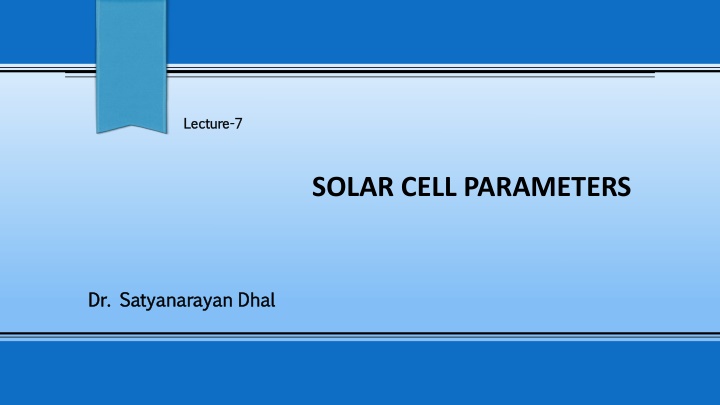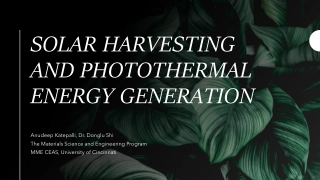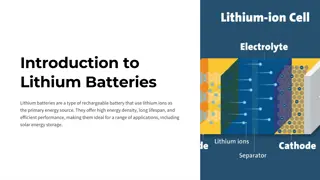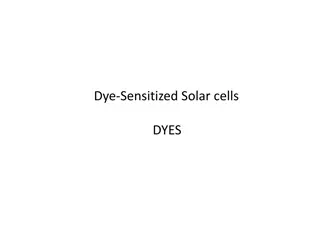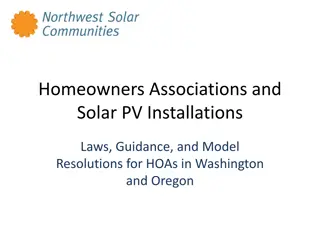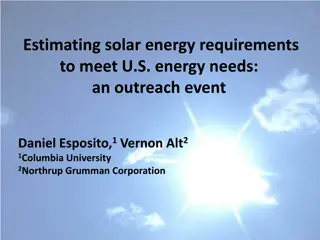SOLAR CELL PARAMETERS
Solar cell parameters such as peak power, short circuit current density, open circuit voltage, fill factor, and their significance in assessing solar cell performance under standard test conditions are explored. Short circuit current density (Isc) and open circuit voltage (Voc) are key factors influencing the efficiency of solar cells. The concept of fill factor and its role in maximizing power output are also discussed, emphasizing the importance of operating at the maximum power point for optimal performance.
Download Presentation

Please find below an Image/Link to download the presentation.
The content on the website is provided AS IS for your information and personal use only. It may not be sold, licensed, or shared on other websites without obtaining consent from the author.If you encounter any issues during the download, it is possible that the publisher has removed the file from their server.
You are allowed to download the files provided on this website for personal or commercial use, subject to the condition that they are used lawfully. All files are the property of their respective owners.
The content on the website is provided AS IS for your information and personal use only. It may not be sold, licensed, or shared on other websites without obtaining consent from the author.
E N D
Presentation Transcript
Lecture Lecture- -7 7 SOLAR CELL PARAMETERS Dr. Satyanarayan Dhal Dr. Satyanarayan Dhal
External solar cell parameters Performance peak power Pmax, short circuit current density Jsc open circuit voltage Voc fill factor Voltage FF,
Standard test conditions 1. Total irradiance on the solar cell that should be measured is equal to 1000 W/m2. 2. Temperature of the solar cell should be kept constant at 25 C.
Short circuit current density (Isc) Defn : - The current that flows through the external circuit when the electrodes of the solar cell are short circuited. The short circuit current of a solar cell depends on the photon flux incident on the solar cell. Isc depends on the area of the solar cell. The maximum current that the solar cell can deliver strongly depends on the optical properties of the solar cell, such as absorption in the absorber layer and reflection.
Short circuit current density (Isc) Ideally, Jsc = Jph, LN and LP are the minority-carriers diffusion length for electrons and holes. Jph = photogenerated current density. Under a uniform generation rate, G, Jph shows that in the case of an ideal diode (for example no surface recombination) and uniform generation, the critical material parameters that determine Jph are the diffusion lengths of minority carriers. Crystalline silicon solar cells can deliver a maximum possible current density of 46 mA/cm2. In laboratory c-Si solar cells the measured Jsc is above 42 mA/cm2, while commercial solar cells have a Jsc exceeding 35 mA/cm2.
Open circuit voltage The open-circuit voltage is the voltage at which no current flows through the external circuit. It is the maximum voltage that a solar cell can deliver. Voc corresponds to the forward bias voltage, at which the dark current density compensates the photocurrent density. where the approximation is justified because of Jph J0 1. Voc depends on the photo generated current density can be calculated from the equation assuming that the net current is zero, Voc depends on the saturation current density of the solar cell and the photo generated current. Commercial solar cells typically have Voc exceeding 600 mV.
Fill factor The fill factor is the ratio between the maximum power (Pmax = JmppVmpp) generated by a solar cell. The subscript mpp denotes the maximum power point (MPP) of the solar cell, i.e. the point on the J-V characteristic of the solar cell, at which the solar cell has the maximal power output. To optimize the operation of PV systems, it is very important, to operate the solar cells (or PV modules) at the MPP. Only carriers generated in the depletion region and in the regions up to the minority-carrier diffusion length from the depletion region can contribute to the photogenerated current. The thickness of the absorber should not be greater than the region from which the carriers photogenerated current. contribute to the J-V characteristics of a p-n junction in the dark and under illumination.
Fill factor and open circuit voltage Voc The importance of the diode ideality factor when introduced into the normalized voltage. graph shown below demonstrates the The ideality factor is a measure of the junction quality and the type of recombination in a solar cell. good approximation of the ideal value of FF for voc > 10. Maximum achievable FF FF does not change drastically with a change in Voc. For a solar cell with a particular absorber, large variations in Voc are not common. E.g. GaAs solar cell may have an FF approaching 0.89. The FF as a function of Voc for a solar cell with ideal diode behaviour.
Conversion efficiency The ratio between the maximal generated power and the incident power. under the STC, where the incident light has an irradiance of Iin = 1000 W/m2, 1. Typical external parameters of a crystalline silicon solar cell as shown are; Jsc 35 mA/cm2, 2. Voc up to 0.65 V 3. FF in the range 0.75 to 0.80. 4. The conversion efficiency lies in the range of 17 to 18%.
Numerical for Practice ??? A crystalline silicon solar cell generates a photo current density of Jph = 35 mA/cm2. The wafer is doped with 1017acceptor atoms per cubic centimetre and the emitter layer is formed with a uniform concentration of 1019 donors per cubic centimetre. The minority-carrier diffusion length in the ptype region and n-type region is 500 10 6 m and 10 10 6 m, respectively. Further, the intrinsic carrier concentration in silicon at 300 K is 1.5 1010 cm 3, the mobility of electrons in the p-type region is n= 1000 cm2V 1s 1and holes in the n-type region is p= 100 cm2V 1s 1. Assume that the solar cell behaves as an ideal diode. Calculate the built-in voltage, the open circuit voltage and the conversion efficiency of the cell. Jph = 350 Am 2. NA= 1017cm 3= 1023m 3. ND= 1019 cm 3 = 1025 m 3. LN = 500 10 6m. LP = 10 10 6 m. DN = (kBT/q) n = 0.0258V 1000 10 4 cm2V 1s 1. DP = (kBT/q) p = 0.0258V 100 10 4 cm2V 1s 1
The external quantum efficiency () It is the fraction of photons incident on the solar cell that create electron-hole pairs in the absorber which are successfully collected. It is wavelength dependent It is usually measured by illuminating the solar cell with monochromatic light of wavelength and measuring the photocurrent Iph through the solar cell. The photon flow is usually determined by measuring the EQE of a calibrated photo diode under the same light source. q is the elementary charge ph, is the spectral photon flow incident on the solar cell. Since Iph is dependent on the bias voltage, the bias voltage must be fixed during measurement. The photon flow is usually determined by measuring the EQE of a calibrated photo diode under the same light source.
The external quantum efficiency () The shape of this EQE curve is determined by optical and electrical losses such as parasitic absorption and recombination losses, respectively, which can make the analysis complex. The minority-carrier diffusion length in the crystalline silicon substrate is very long and surface recombination is virtually suppressed. We can identify the major optical loss mechanisms in the EQE for such a solar cell: For short wavelengths only a small fraction of the light is converted into electron-hole pairs. Most photons are already absorbed in the layers that the light traverses prior to the absorber layer; this is called parasitic absorption. For long wavelengths, the penetration depth, exceeds the optical thickness of the absorber. Then the absorber itself becomes transparent so that most of the light leaves the solar cell before it can be absorbed. solar cell. A typical EQE for a high quality crystalline silicon-based
